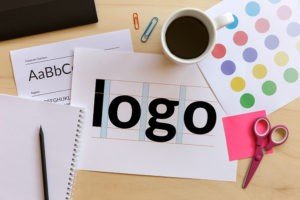 Mention the word “logo” and chances are your mind would be filled with images of popular logos like the Nike swoosh, the three stripes of Adidas, the golden arches of McDonald’s, Coca-Cola’s bright red cursive font and Apple’s, well, apple.
Mention the word “logo” and chances are your mind would be filled with images of popular logos like the Nike swoosh, the three stripes of Adidas, the golden arches of McDonald’s, Coca-Cola’s bright red cursive font and Apple’s, well, apple.
These world-famous logos certainly leave a lasting impression in people’s minds. However, there’s more to logos than design and this article will provide you with much-needed logo design tips.
As a small business owner, you might not think much about the importance of having a good logo.
You probably think of it as just a decorative design element that you have to use in marketing materials.
But if you’re looking to build a long-term business, you’ll probably agree that a solid logo and branding design is definitely a must have, right?
A Visual Symbol
A logo is one of the first things you notice about a business or a brand. A brand is an image and personality that a company applies to its products, while a company refers to the business that produces and markets a product.
However, they can both overlap and be used to refer to the same thing.
As the visual symbol of your brand, your logo represents your brand and business.
It is part of your business identity. This symbol is how people remember your brand. It reflects your company’s purpose and values.
A logo that is a good representation of your business creates familiarity and ultimately, a sense of trust in the minds of your customers, which makes it more likely that they’ll buy from you.
Key Marketing Element
While the most important element in marketing your brand is your brand name itself, another key element is your logo.
As the visual representation of your business, your logo appears on company signs, letterheads, marketing materials, properties and advertisements.
And being the most visible element of your business, it makes up your audience’s very first impression of your business.
It’s lot easier to remember than a name. The combination of a well-chosen name and a logo can ensure a successful identity that can ultimately lead to a successful business.
Now that we know the importance of logos in marketing your business, let’s take a look at the different types and how you can create a powerful one that attracts customers.
Types of Logos
There are many combinations of colors, letters, illustrations and styles used in logo design.
Logos may be text-based, illustrations or abstract symbols. Some use a combination of these types.
Many small business logos are built upon two primary elements: their typographic elements and their graphic element.
Together, these factors form the basic structure for most designs.
1. Text Logos or Wordmarks
These are uniquely styled logos that consist of the company name or brand name only. Carrying only the company’s name, this type communicates the brand instantly to its customers.
Usually, businesses create custom fonts for their logo to stand out. Examples of these are Facebook, Google, Yahoo, Disney and Sony.
This is a good type for startups because it allows consumers to easily recognize a new business by its name.
2. Letter Marks
Often, businesses with long names use their initials as their logo. Highly stylized letters are used so that the mark is distinctive enough to stand-alone.
HBO, IBM, CNN, Hewlett-Packard, Procter & Gamble, Louis Vuitton and General Electric are good examples.
3. Symbols or Icons
Companies have used symbolic logos for decades. Among them are Apple, Twitter, Target and Mercedes-Benz.
This type represents the company with an image that may be abstract or literal to give visual interest.
Literal illustrations, like bread for a bakery business, make it crystal clear what a company does.
Abstract symbols allow you to be creative in coming up with a truly unique design to represent your brand.
Using an abstract logo triggers curiosity and forces customers to think of what your business is about.
4. Combination Mark
These logos combine a word mark and a symbol or icon. This type makes it flexible to be used as either or both elements across a variety of applications.
An expertly-crafted combination mark works just as well with the elements separate as it does when they’re combined.
Some famous combination marks include Burger King, Lacoste, Adidas, Sprint and Puma.
5. Emblem
An emblem logo encloses the company name within the design. Badges, crests and seals come to mind.
With their traditional appearance, schools, organizations or government agencies often use emblem logos. Some examples include Starbucks, Ford, Converse and Harley-Davidson Motorcycles.
6. Mascot
Think of the Michelin tire man. KFC is also a classic example of the mascot.
The company’s illustrated depiction of Colonel Sanders is a wholesome image that appeals to families and children.
Benefits of Having a Good Logo
It’s a crucial part of any company’s complete marketing plan because it is used extensively to promote a brand or business.
So what are the benefits of having a professionally designed logo and identity system?
Here they are:
1. Branding
For a small business, branding is an opportunity to make a good first impression on customers.
People will most likely remember what they see than what they hear or read. Having a logo with a strong recall factor is critical.
Your business will probably be the first one that potential clients think of when they need your goods or services.
A well-designed logo can be helpful in building and maintaining a certain image for your brand too. Branding is very important, not only for uniqueness but more so for recognition.
That’s why your logo should give a clear idea of what your business does. In this regard, your logo helps to build your corporate identity.
It also makes promoting your company easier. When placing this image on marketing collateral, your online channels such as websites and social media networks, you give people consistent exposure to your brand.
The more people see your logo, the more they identify the logo with your business and what you offer.
2. Stand Out From Your Competitors
With so many brands on the market, it is important that you have a good quality logo that stands out against your competitors.
A striking logo that sits well on your website, social media networks and marketing materials can make a huge difference when it comes to advertising.
An attention-grabbing logo will prompt customers to think of you when they need your products and services. In many cases, you’ll effortlessly win over potential customers.
With an extraordinary logo, your customers will be less likely to consider the competition.
3. Conveys a Professional Image
A professional logo can indicate that you know what you’re doing. It creates the impression that you are experienced and familiar with your industry.
And it also gives your clients confidence in your ability to deliver good work. A professional image shows that you care enough to invest in your identity.
It shows that you are dependable and committed to both your business and clients. It goes a long way toward building that all-important “trust.”
4. Evokes Trustworthiness
A well-designed logo can make your business look reliable and trustworthy. Customers look for brand authenticity and reliability.
Businesses can express this by expressing a consistent message that creates a positive impact on your brand reputation.
What Does a Good Logo Look Like?
Ultimately, a business logo should be designed for your customers, not for you.
Experts advise against creating one based on your own personal preference because your target market will probably find it difficult to connect with.
A great logo should have the following qualities:
Distinctive and Impactful
Logos help customers quickly identify your business. The more distinctive and impactful it is, the more recognizable it becomes.
Attractive
An attractive logo makes it easy for your customers to recall it.
Simple but Clear
A simple design is easy for consumers to understand. Simplicity helps make the message clear and concise.
Represents Your Brand
It depicts what your brand is all about, so it must be in line with your business philosophy. It should also reflect quality products and services.
Easy to Explain
You shouldn’t have to tell a long, complicated explanation to describe your logo to others.
Easily Recognizable
Out on the street, you spot a logo from the corner of your eye. Can you quickly recognize which company that is? Great logos bring a particular brand to mind right away.
Elicits Emotional Response
People should react according to your intended response when they see your logo.
Changeable and Scalable Across all Media
Good designs are easy to publish across different media, including print, online, signs, promotional items, etc.
It can also be easily enlarged and reduced or compressed in whatever medium it is used.
Logo Design Tips For Creating a Powerful Logo
The success of any business is largely down to image. A logo is necessary for creating a good first impression and building a good relationship with your target audience.
Your design should be a fundamental part of your branding and should conform to all other visual assets of your business.
Consider your brand first when deciding on a logo. Think about your company’s mission statement.
Do your research and know who your clients are, what they want from you and what you want from them.
All the design choices made in logo creation basically represent the company in a definite way, whether modern, classic, family-oriented, sexy or masculine.
Graphics, fonts and colors all work together to create this image.
For designers, when designing logos for companies, consider how it can send an image that appeals to their target audience, including how it can differentiate the company from the competition.
Your logo is the first thing that new customers will see, so you want to make sure that they see your business in a positive light.
Even if you’re a small business, you can create a powerful logo that attracts customers. Just make sure to consider these factors:
1. Make it Relevant
Is your logo appropriate or relevant as a symbol of your company? Also, consider whether it feels authentic to your industry.
Carefully choose your images or symbols to avoid any confusion by your audience on how they perceive your company and products or services.
2. Make it Truly Unique
Be different. Set your business apart from the competition. Ensure that your logo is not confused with another company’s design.
3. Keep it Simple
Remember: less is more. Clarity is achieved through simplicity of design.
Cramming too much into a logo will make it look cluttered and confusing. Images with lots of texts and fine details tend to lose clarity when used in small dimensions.
Special effects can also lessen the impact of an otherwise fine design.
Try to stick to simple, streamlined design with one simple shape or symbol for maximum clarity and impact.
4. Make it Clear
Make sure that your logo is clear and easy to interpret.
Your logo is the face of your brand. As you build brand awareness, people will begin to associate your logo with your business.
Complicated designs can make it difficult for people to create those associations.
Avoid using a design that requires a lot of explanation. While having a memorable icon is important, it should be one that helps the consumer quickly link to your message.
5. Communicate a Unified Message
Your logo also serves as a sales pitch for your company’s products and services.
You need to quickly convey the message that you want to come across, what you have to offer and what sets you apart from competitors in seconds.
What are the thoughts and emotions that your audience feels when they take a look at your logo?
Words, shapes, colors and combinations of these set off emotional responses that correspond to your audience’s reaction to your business.
Find out how you can convey what you have to offer to clients. How do you express healthy living or cutting-edge technology?
Your logo needs to convey what you do and who you are, as well as leave your customers with a positive brand experience.
6. Think About Your Target Audience
When designing a logo, you need to take into account your audience’s point of view along with your taste.
To know your audience’s thoughts, what you can do is ask for feedback from a few people who mirror the characteristics of your target audience.
Do this before giving the final approval to your logo design.
7. Design Elements Should Work Together
All of the elements or attributes, its color, shape or text, needs to serve a specific purpose.
This purpose should help reinforce the brand it represents. While they should be explored individually, fundamentally all the elements of your logo are interconnected.
The better the designs work together, the greater the value of the logo.
Psychology is largely applied in marketing. When adding each element, consider the emotion that it evokes in customers. Research shows that color influences the buyer’s decision-making process.
When considering a logo for your company, keep in mind what it means, its symbolic representation and any resemblance to your product.
When you want some kind of text in your logo, the type of font you choose is important. The typography and graphic used should create a balanced design.
Choose colors wisely. Choose colors based on the emotions you want your brand to evoke in your audience and the story that your brand tells.
You can play to traditional tastes, like in the heating and air conditioning industries where they often use red and blue in their branding.
But you can also think creatively when picking your brand colors.
McDonald’s uses red and yellow in their logo. Bright, fun and high-energy, these colors easily attract the attention of children.
To know what colors are associated with which emotions, check out this article on the psychology of colors.
8. Company Vision
The future outlook and a vision of growth for your business should be considered.
A logo should be forever. Even if some companies change their logo, often they do it to create a fresh look on an old basic design.
However, this is normally a huge risk, as existing customers might not like the new design.
9. How Your Logo Will be Used
Remember that your graphic will be used in different dimensions, so it should translate well across various platforms.
Create a simple enough design that’ll give a crisp impression whatever its size. Using vector graphics usually does the trick.
Think about how the logo will look on your products. How will it appear on advertising and marketing materials, in print or online media, in websites and social media channels?
Think about how this logo will look on business signs, vehicles and packaging. How will it appear when it’s small and when it’s on a notepad?
What will it look like when it’s blown up in a huge billboard located along the highway?
10. Analyze The Competition
Yes, you should look at the competition. Not to copy, but to have an idea of what is working and what isn’t in your industry.
Doing research on the competition will hopefully give you an understanding of your target audience’s thoughts on branding.
11. Hire a Professional
A new business owner dilemma is always this: Should I hire a professional service provider when I’m just a small business?
Consider that your logo will be the face of your brand for many years to come.
It’s super worth it to hire an experienced graphic designer who has already created logos for businesses within your industry.
Be sure to provide a clear design brief and reasonable price to gain the attention of the best graphic designers.
Have an open dialogue with your designer to manage expectations. Share your ideas with the designer and work together to create the best logo for your company.
Make sure that all artwork created is original, not sourced from ordinary clip art.
Going the DIY route in creating a logo may seem like the best way to avoid the costs of hiring a professional design firm but know that there’re a lot of independent designers who charge much less.
While you don’t need to pay a lot of money or bring a graphic designer on staff, you should definitely invest in a design that won’t embarrass your company.
Give Your Brand The Attention That it Deserves
The process of creating a logo is relatively easy. However, making a powerful one requires thoughtful planning using the unique aspects of your business.
Creating a simple yet powerful design indicates a keen awareness of a logo’s purpose and your ideal client needs.
To achieve this, you may want to hire a design company or professional who has a clear understanding and appreciation of the psychology involved in marketing.
Requiring the efficient use of precious resources, starting or growing a business is not easy.
When making decisions about how to invest your time, energy and money, remember that in today’s marketplace and its cutthroat competition, you cannot afford to take shortcuts when it comes to your branding.
Most likely, creating a good logo will be one of the most important decisions you’ll ever make. Something that represents your brand deserves your full attention and best efforts.
How to Design a #Logo That Attracts #BusinessClick To Tweet
I’m a freelance copywriter and SEO specialist. I aim to empower individuals and businesses with impactful marketing solutions and insights. In my downtime, I recharge by embracing the beauty of nature or cherishing moments with my loved ones. If you found value in this post, please consider sharing it.
Want a heads-up whenever a new article drops? Subscribe here






